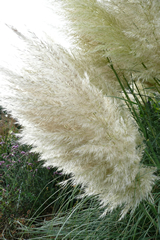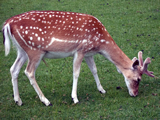If you're having trouble reading this from your email, click here to access it through your internet browser.


Ornamental plants
- Continue to deadhead flowers to keep displays going as long as possible.
- This month is your last chance to take cuttings from tender plants.
- Collect seeds from your perennials and annuals to sow next year or swap with friends.
- Cut down the flowered stems of spent perennials.
- Fill in gaps in your displays with autumn-flowering bulbs and bedding (such as nerines and gentians).
- Start to plant out your spring bedding, such as violas and wallflowers.
- Small evergreen shrubs, conifers and trees can be moved over the autumn.
- Plant hyacinth bulbs by the middle of the month to have Christmas flowers.
- Start to water cyclamen corms to break their summer dormancy.
- Sow lettuce, spring cabbages, winter spinach, cauliflowers, Chinese cabbages, pak choi, hardy spring onions and rocket.
- Plant hardy onion sets for early summer crops.
- Sow green manure (eg forage rye) in empty beds to suppress weeds and provide nutrients when dug back in in the spring.
- This month you should be able to harvest autumn raspberries, blackberries, early apples, Conference pears, sweetcorn, marrows, courgettes, beans, lettuce, rocket, spring onions, Chinese leaves, oriental radishes, autumn cauliflower, cabbages, pencil leeks, maincrop potatoes, onions, shallots, garlic and globe artichokes.
- Prune out fruited canes from blackberries and loganberries.
- Cut down the foliage on asparagus plants once it turns yellow (which may not happen until next month).
- Keep an eye on night time temperatures and cover crops to protect them from the cold.
- Pot up or dry herbs for use over the winter.
- Start to bring tender plants under cover this month as overnight temperatures start to dip.
- Clean any shading paint off your greenhouse now to let more light in.
- Raise the height of your mowing cut and start to mow less frequently as the grass growth slows.
- Last chance to trim hedges before the winter.
- Cover ponds with netting to stop leaves falling into them.
 Plant of the month
Plant of the monthCortaderia selloana 'Pumila', a dwarf pampas grass, is in full bloom now. The cream-coloured, fluffy plumes reach about 1.5m height, while the arching, dark green foliage forms a clump of about 1.2m spread.
This is a relatively low maintenance plant just needing pruning and protection in winter. Find out more...


Deer may be attractive animals, but they can be a real menace in gardens. Frayed bark and chewed new shoots are good indicators of these shy creatures. To prevent damage you can erect barriers, use deterrents and plant less deer friendly plants. Or why not provide them with some of their favourite foods so they aren't so tempted by your borders? Find out more...

UK's Next garden centre chain?
Fashion retailer Next has opened its first garden centre at Shoreham-by-Sea. The company intends to use this as a 6 month test to judge the feasibility of continuing to develop this market.
Busy Lizzies' days seem to be numbered
Numerous councils are reviewing whether to continue planting Impatiens (Busy Lizzies) in public garden bedding schemes as impatiens downy mildew devastated displays in both public and private gardens this year. The disease has evolved to become immune to pesticides and the spores can remain in the soil for up to 10 years after infection.
Veg goes multicoloured
Supermarket chain Tesco appear to be at the forefront of a growing trend to produce interesting coloured vegetables. UK suppliers have so far provided the chain with golden raspberries, pink oyster mushrooms and cauliflowers in vivid oranges, greens and whites!

What do compost heaps eat?
As autumn strolls on we'll be creating plenty of compostable materials in the garden, be they the remains of the summer's herbaceous perennials, the first fallen leaves or the final hedge trimmings. The key to successful composting is to give it the right mix of ingredients so it can cook them up and serve you with a large helping of wonderfully rich compost for the following year.
When feeding your compost heap, you need to ensure you have a good balance between 'green' nitrogen rich materials and 'brown' carbon rich materials. Getting the balance right helps the microorganisms in your heap do their job and turn your rubbish into fabulous compost. These microorganisms need carbon and nitrogen to survive, so if you give them loads of nitrogen and only a little carbon they will stop working because of a lack of carbon.
You should aim for roughly an even balance between carbon rich and nitrogen rich materials, erring on the side of putting more carbon rich materials in (so long as you don't put more than twice as much carbon versus nitrogen).
Carbon rich rubbish includes straw, hedge clippings and leaves, while nitrogen rich materials include grass clippings and kitchen waste.

What's on this month
A few of the UK gardening delights you can sample this month...
- 2nd to 4th September - Suffolk Autumn Garden Show, Ipswich, Suffolk.
- 2nd to 4th September - Dundee Flower And Food Festival, Camperdown Country Park, Dundee.
- 2nd to 4th September - National Gardening Show, Royal Bath And West Showground, Somerset.
- 4th September - Plant Hunter's Fair, Ness Botanic Gardens, Cheshire.
- 7th September - Gardeners' Q&A, Montacute House, National Trust, Somerset.
- 10th & 11th September - Autumn Kent Garden Show, Detling, Kent.
- 16th to 18th September - Harrogate Flower Show, Great Yorkshire Showground, Harrogate, North Yorkshire.
- 18th September - Rare Plant Fair, Llanover House, near Abergavenny.
- 22nd September - Seed Collection And Storage Masterclass, Culzean Castle And Country Park, National Trust For Scotland, Ayrshire.
- 24th & 25th September - Malvern Autumn Show, Malvern, Worcestershire.
